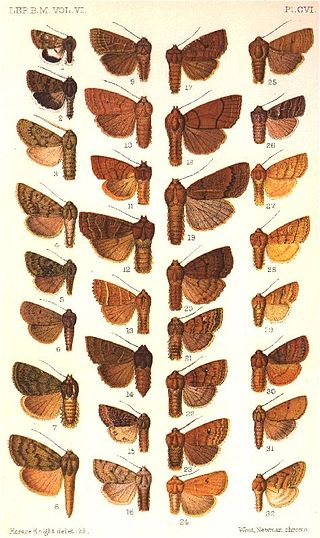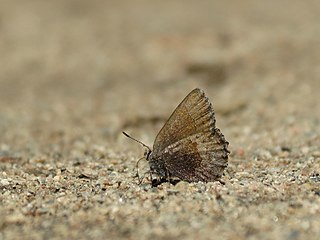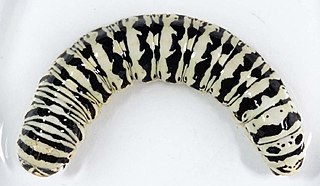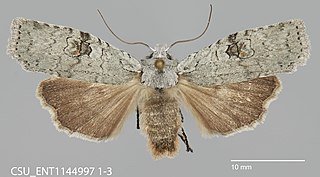
A bark beetle is the common name for the subfamily of beetles Scolytinae. Previously, this was considered a distinct family (Scolytidae), but is now understood to be a specialized clade of the "true weevil" family (Curculionidae). Although the term "bark beetle" refers to the fact that many species feed in the inner bark (phloem) layer of trees, the subfamily also has many species with other lifestyles, including some that bore into wood, feed in fruit and seeds, or tunnel into herbaceous plants. Well-known species are members of the type genus Scolytus, namely the European elm bark beetle S. multistriatus and the large elm bark beetle S. scolytus, which like the American elm bark beetle Hylurgopinus rufipes, transmit Dutch elm disease fungi (Ophiostoma). The mountain pine beetle Dendroctonus ponderosae, southern pine beetle Dendroctonus frontalis, and their near relatives are major pests of conifer forests in North America. A similarly aggressive species in Europe is the spruce ips Ips typographus. A tiny bark beetle, the coffee berry borer, Hypothenemus hampei is a major pest on coffee plantations around the world.

Asclepias purpurascens, the purple milkweed, is a herbaceous plant species. It is in the genus Asclepias, making it a type of milkweed. It is native to the Eastern, Southern and Midwestern United States similar to the range of the common milkweed. The plant gets its name from the flowers that first develop a pink color but then turn darker purple as they mature. Unlike common milkweed, purple milkweed prefers some shade and is considered a plant of partial shade. It is also considered an indicator of oak savanna, especially in Wisconsin. The species rarely produces seed pods which are smooth, instead of the rough warty ones produced by common milkweed.

Acronicta lanceolaria, the lanceolate dagger moth or pointed dagger, is a moth of the family Noctuidae. The species was first described by Augustus Radcliffe Grote in 1875. It is found in North America, from Nova Scotia to British Columbia. It is listed as a species of special concern and believed extirpated in the US state of Connecticut.

Psectraglaea is a monotypic moth genus of the family Noctuidae described by George Hampson in 1906. Its only species, Psectraglaea carnosa, the pink sallow, described by Augustus Radcliffe Grote in 1877, is native to North America. It is listed as threatened in Connecticut, and as a species of special concern in Massachusetts.

Agrotis stigmosa is a moth of the family Noctuidae first described by Herbert Knowles Morrison in 1875. It is found in North America from New England and Quebec west to Colorado and eastern Alberta. It is listed as a species of special concern in the US state of Connecticut.

Acronicta falcula, the corylus dagger moth, is a moth of the family Noctuidae. The species was first described by Augustus Radcliffe Grote in 1877. It is found in the United States and Canada from southern New England to southern Manitoba and Iowa. Recently seen from Wisconsin, Connecticut, Rhode Island, New York and Michigan. It is reported as rare in Ohio. It is listed as a species of special concern in the US state of Connecticut.
The Death Valley June beetle is a scarab beetle in the subfamily Melolonthinae. It is only known to occur in the drainage basin of the Amargosa River in the southwestern United States. Saltgrass communities, such as those at Saratoga Springs in Death Valley, provide habitat for the insect at all stages of its life.

Callophrys polios, the hoary elfin, is a butterfly of the family Lycaenidae. It is listed as a species of special concern and believed extirpated in the US state of Connecticut.
Apodrepanulatrix liberaria, the New Jersey tea inchworm, is a moth in the family Geometridae. It was described by Francis Walker in 1860. It is found from extreme southern Quebec and southern Ontario southward into northern Florida and Mississippi. It is listed as endangered by state authorities in the US states of Massachusetts and Connecticut.

Glena cognataria, the blueberry gray moth, is a moth native to North America. It ranges from Florida to Nova Scotia and New Brunswick. Its larvae are hosted on blueberry. The habitat consists of bogs and pine barrens. It is listed as a species of special concern and believed extirpated in the US state of Connecticut.
Chaetaglaea cerata, the waxed sallow, is a species of moth in the family Noctuidae described by John G. Franclemont in 1943. It is found in North America, where it has been recorded from Connecticut, Indiana, Maine, Michigan, Ohio, Ontario, Pennsylvania and Wisconsin.

Cucullia speyeri, common names Speyer's paint, Speyer's cucullia or Speyer's hooded owlet moth, is a moth found in North America. It is found from Alberta and Montana to the Atlantic coast from New Hampshire to Virginia. It was described by Joseph Albert Lintner in 1874. In the US state of Connecticut, it is listed as a species of special concern and is believed to be extirpated. The habitat consists of open meadows, dry grasslands and native prairies.

Hyparpax aurora, the pink prominent, is a moth in the family Notodontidae found in eastern North America. The species is listed as being of special concern in the US state of Connecticut. The species was described by James Edward Smith in 1797.
Papaipema circumlucens, the hops-stalk borer moth, is a species of moth native to North America, where it has been recorded from Illinois, Indiana, Michigan, Missouri, New Hampshire, Ohio, Saskatchewan and Wisconsin. The species was described by Smith in 1899. It is listed as a species of special concern and is believed to be extirpated from the US state of Connecticut.
Papaipema maritima, the maritime sunflower borer moth, is a species of moth found in North America. The species was first described by Henry Bird in 1909. The larvae bore into the stems of Helianthus giganteus, forming a stem gall. It is listed as a species of special concern and believed extirpated in the US state of Connecticut.
Digrammia equivocata, the equivocal looper, is a species of moth native to North America. It is listed as historic in the US state of Massachusetts, and as a species of special concern in Connecticut. The larval host plant is Tephrosia virginiana. It was described by Douglas C. Ferguson in 2008.
Euxoa violaris, the violet dart moth, is a species of moth native to North America. It is listed as a species of special concern in the US state of Connecticut. It was described by Augustus Radcliffe Grote and Coleman Townsend Robinson in 1868.
Fagitana littera, the marsh fern moth, is a moth of the family Noctuidae. It is listed as a species of special concern in the US state of Connecticut. It was described by Achille Guenée in 1852.

Lithophane viridipallens, the pale green pinion moth, is a moth of the family Noctuidae that is native to North America. It is listed as a species of special concern in the US state of Connecticut. It was described by Augustus Radcliffe Grote in 1877.

Sympistis riparia, the dune sympistis, is a moth of the family Noctuidae. The species was first described by Herbert Knowles Morrison in 1875. It is native to North America and it is listed as a species of special concern in Massachusetts and in Connecticut.










